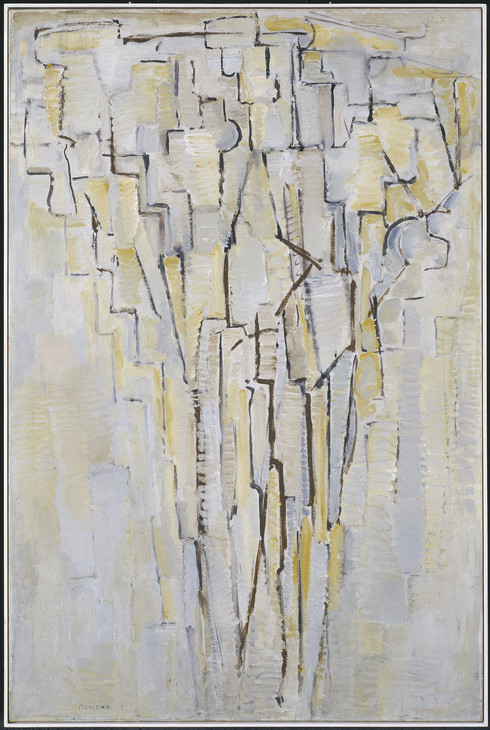Piet Mondrian’s The Tree A
Philip Shaw

Piet Mondrian 1872–1944
The Tree A circa 1913
Oil on canvas
support: 1003 x 673 mm; frame: 1047 x 718 x 50 mm
Tate T02211
Purchased 1977
© 2007 Mondrian/Holtzman Trust c/o HCR International, Warrenton, VA
Fig.1
Piet Mondrian
The Tree A circa 1913
Tate T02211
© 2007 Mondrian/Holtzman Trust c/o HCR International, Warrenton, VA
Trees were objects of particular fascination for the Dutch artist Piet Mondrian. In 1908 the artist had painted a vibrant, semi-abstract yet recognisably naturalistic picture entitled Evening; Red Tree (Haags Gemeentemuseum, The Hague). A few years later, in 1911, he completed a painting called Grey Tree (Haags Gemeentemuseum, The Hague), which appears to endorse a Kantian position on the sublime. In this work, conceived under the influence of cubism, Mondrian eschewed the depiction of objective reality, along with the lively, expressive colours of his earlier works, for an increasingly abstract, monochrome style of painting. By 1913, the year in which The Tree A (Tate T02211, fig.1) was most probably completed, the artist had gone even further. In this picture there is no attempt to convey the illusion of depth or perspective; the image is entirely flat. Gone too are the bold, gestural brush strokes that had characterised his earlier paintings; the intensely wrought trunk and branches of Grey Tree have been replaced by a network of coolly articulated horizontal and vertical lines. It is possible to see in this painting the beginnings of Mondrian’s mature style, with its chequerboard of horizontal and vertical lines and clearly delineated blocks of colour.
Writing in De Stijl (The Style), the magazine founded by the artist Theo van Doesburg in 1917, Mondrian asserted that the
cultivated man of today is gradually turning away from natural things, and his life is becoming more and more abstract. Natural (external) things become more and more automatic, and we observe that our vital attention fastens more and more on internal things.1
The artist goes on to state that ‘as a pure representation of the human mind, art will express itself in an aesthetically purified, that is to say, abstract form’.2 In rejecting nature, Mondrian seems to have in mind Kant’s argument on the ‘Analytic of the Sublime’, from The Critique of Judgement (1790), concerning the unrepresentable faculty of reason. For Kant, reason is sublime because it cannot be depicted in a sensible or natural form. For Mondrian, however, the commitment to abstraction is primarily spiritual rather than rational. A sometime follower of the esoteric religious philosophy known as theosophy, Mondrian maintained that the strict geometric lines in his later paintings were an attempt to convey the ‘dynamic equilibrium’ of the universe, with the horizontal representing the feminine, or material, and the vertical, the masculine and the spiritual.3
Mondrian’s theory and achievement as an artist is questioned by the American abstract expressionist painter Barnett Newman in his 1948 essay ‘The Sublime is Now’. In this essay Newman writes: ‘Mondrian ... succeeded only in raising the white plane and the right angle into a realm of sublimity, where the sublime paradoxically becomes an absolute of perfect sensations’. Newman concludes that the ‘geometry (perfection) [is] swallowed up his metaphysics (his exaltation)’.4 Mondrian remains, in other words, an essentially Romantic artist, wedded to the realm of nature even as he gestures towards the exalted sphere of the pure or abstract sublime.
Notes
Piet Mondrian, ‘Natural Reality and Abstract Reality’ (1919), in Herschell Browning Chipp (ed.), Theories of Modern Art (Berkeley and Los Angeles: University of California Press, 1968), pp. 321-5; p. 321.
Piet Mondrian, ‘Plastic Art and Pure Plastic Art (Figurative Art and Non-Figurative Art)’ (1937), in Browning Chipp (ed.), Theories of Modern Art, pp. 349-62; p. 355.
Philip Shaw is Professor of Romantic Studies in the School of English at the University of Leicester and Co-Investigator of ‘The Sublime Object: Nature, Art and Language’.
How to cite
Philip Shaw, ‘Piet Mondrian’s The Tree A ’, in Nigel Llewellyn and Christine Riding (eds.), The Art of the Sublime, Tate Research Publication, January 2013, https://www
